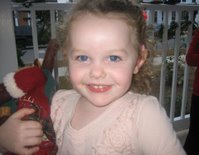Baby becomes youngest cochlear implant recipient in Illinois
and this article:
Early cochlear implants get deaf toddlers talking
Media Release, Thursday 7 December 2006
Deaf babies and toddlers can develop normal language skills when cochlear implants occur between six months and two years, according to new research released by the University of Melbourne.
“This is the first study investigating the long term language progress of deaf babies and toddlers implanted with Cochlear implants,” said Head of the Department of Otolaryngology at the University of Melbourne, Professor Richard Dowell.
The results were revealed after a major clinical study of over 100 infants implanted between six months and two years of age was conducted at the Cochlear Implant Clinic at the Royal Victorian Eye and Ear Hospital.
“Results have shown that implantation in an infant under 12 months has a significant impact on their language skills, “said Dr Shani Dettman of the University of Melbourne, who coordinated the study.
“The most important time for developing communication skills is below 12 months of age. This is a critical period for language growth,” Dr Dettman said.
“Prior to the introduction of early screening tests and cochlear implantation, profoundly deaf children experienced significant delays in language development,” she said.
“What we have found is that the children who received implants before 12 months of age had better language than the children who received implants between one and two years of age,” she said
“Until recently, most parents were choosing to go ahead with a cochlear implant when the child was between one and two years of age.”
“We now have definitive evidence to recommend that parents decide even earlier. This research is backed up by similar studies carried out in Europe and the U.S.”
The study involved a three month pre testing period of communication assessment, hearing tests and radiological scans, and then long term follow up years after the implant operation.
Dr Shani Dettman said the research will have a huge impact on the lives of the children and their learning capabilities.
“It is wonderful to watch the children begin to respond to their hearing, and learn to communicate. These children can joke, lie, tease and use language in all its forms,” she said.
“Ultimately it’s about providing more communication choices and better education, social and vocational opportunities,” she said.
“The deaf children we have in our early intervention program show great interaction with other hearing children,” said Program Coordinator of the Early Education Program for Hearing Impaired Children, Rita Corbett.
The major Cochlear implant device used around the world grew out of research at the University lead by Professor Graeme Clark. This device, manufactured by the Australian company Cochlear Ltd, is now used by over 80,000 deaf people.
MEDIA CONTACT
Rebecca Scott, University of Melbourne
Mobile: 0417 164 791
Sonia Aplin, Royal Victorian Eye and Ear Hospital
Mobile: 0412 887 170
More information about this article:
Rebecca Scott
Media Promotions Officer
rebeccas@unimelb.edu.au
Tel: +61 3 8344 0181
Mob: 0417 164 791
We are lucky in the sense that Lily's type of hearing loss has enabled her to acquire a great deal of speech. I have pretty high hopes that even though she is a "late" implantee in comparison to other deaf children, she has had the advantage of a progressive hearing loss and she will be able to catch up to her peers and will do as well as those children who are implanted at very young ages.




